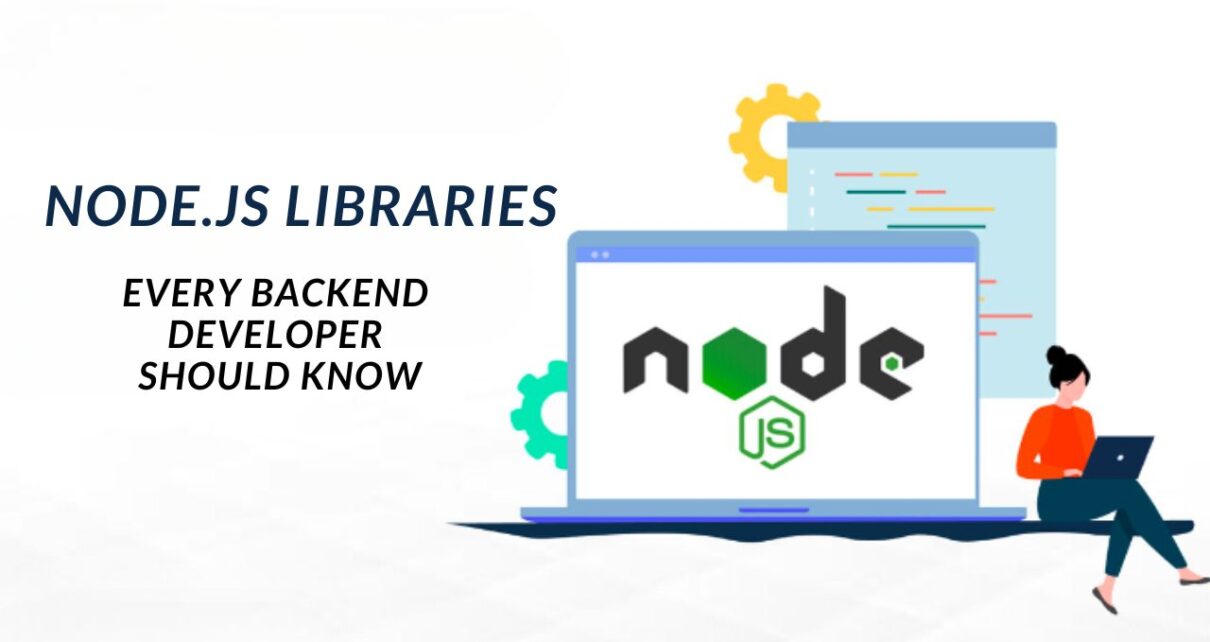Node.js has remained dominant in the back-end development sector due to its event-driven and non-blocking design, as well as the flexibility it provides for developers. However, the real power of Node.js lies in its rich ecosystem of open-source libraries that make development easier and help reduce the time-to-market of complex applications. Businesses can hire node.js developers to get optimized solutions.
Scalable APIs, background job processing, real-time features, and big data management all present an opportunity to drastically increase the performance, maintainability, and scalability of your application using the appropriate libraries. Leveraging the right tools can significantly streamline development and reduce technical debt. That’s why many tech-driven businesses choose to hire Node.js developers who are skilled in implementing these powerful solutions.
This blog will discuss 10 Node.js libraries that any backend developer in 2025 should know.
Top 10 node.js libraries
1. Express.js – The Web and API Development Base
Express and its counterparts are some of the most well-liked and reliable web frameworks within the Node.js ecosystem. It gives a neat framework to work with routing, middleware, HTTP requests, and responses.
Express is used in the majority of backend applications (startups and enterprise-level systems) to create RESTful APIs, serve static files, or do server-side rendering. The key features of Express are its straightforwardness and scalability, which enable developers to extend behavior without complications and embed other tools without effort.
Express can minimize boilerplate code, accelerate development, and have a vast number of community-maintained middleware packages, which is why it is the framework of choice when building scalable server-side applications.
2. Sequelize – SQL Database Made Easy
SQL database management can be complicated, particularly when working with raw queries, joins, and migrations. Sequelize makes that easy by providing an Object-Relational Mapping (ORM) layer, which enables developers to utilize databases with familiar JavaScript syntax.
It enables popular SQL databases, including PostgreSQL, MySQL, and SQLite. Sequelize enables developers to specify models, relationships, and validations, while providing tools to manage migrations and transactions.
It is particularly useful in large-scale applications where relevant database interactions, scalability, and maintainability are of prime concern. It minimizes the possibility of introducing database-related bugs and makes the code modular and structured.
3. Mongoose – Organize your MongoDB Data
Although MongoDB is commonly referred to in connection with its schema-less flexibility, the real world usually needs structure and data validation. Mongoose gives an abstraction layer which introduces schema definitions, relationships, and validation to applications of MongoDB.
It allows developers to specify rigid data models, establish document relationships, and provide middleware hooks like pre-save logic. This makes manipulation of data more predictable and secure, less prone to errors, and more consistent.
Mongoose is a tool that helps developers of NoSQL databases in e-commerce, content management, and social applications to keep the data in the application properly organized and managed. Businesses can also leverage MongoDB development services to implement Mongoose efficiently and scale their applications with expert support.
4. Joi – Declarative and Powerful Data Validation
One of the most important layers in backend development, in general, and APIs in particular, where external data is continuously accepted, is data validation. Joi provides a readable and declarative interface to validate an incoming value, be it a user sign-up form or a complicated nested object.
The notable feature of Joi is the possibility to specify the schema that provides a clear expression of validation rules. Developers can require types, ranges, required fields, and even arbitrary validation logic, all in a single location.
It’s a crucial tool to ensure input integrity and protect applications from invalid or malicious data. It also boosts the reliability of backend services.
5. Winston -Professional Logging Made Simple
Logging is the first line of defense. It helps you understand what happened during a production failure. Winston is a powerful and flexible logging library. It lets developers create logs with different severity levels and send them to various destinations.
It covers several formats and transports, like console, files, databases, and third-party monitoring tools. Such flexibility permits the specification of elaborate logging strategies to suit the needs of your application.
Debugging, performance monitoring, and audit trails all require good logging. Winston enables backend teams to know what is going on in the application at any one time – without introducing excessive complexity.
6. Passport – Modular Authentication Any Use Case
Authentication represents a key component of any backend application, and Passport offers a flexible but built-in strategy to manage it. Passport supports more than 500 strategies: local login, social logins (Google, Facebook) and enterprise integrations (OAuth, SAML). Passport can help you add secure authentication to your apps in no time.
Its extensibility allows developers to decide what authentication system (session-based or token-based, such as JWT) to use based on the requirements of their application.
Whether you are creating a SaaS application or a mobile backend, Passport will save you time and prevent you from falling into typical security traps by leveraging proven authentication flows.
7. Dotenv – Safe and Easy Environment Management
Backend systems use environment variables to set settings in development, staging, and production. Dotenv is a tiny yet mighty library that will load environment variables based on a centralized .env file and keeps them out of your source code.
This simplifies the management of secrets such as database credentials, API keys, and configuration flags more securely. It also eases deployment and scaling by letting you configure each environment with a dedicated configuration file.
Dotenv promotes clean, scalable, and secure best practices for managing sensitive data within any Node.js application.
8. Socket.IO – Real-time communication on the new web
When real-time communications are part of your application (such as chat, live dashboards, or notifications), use Socket.IO as your library of choice. It simplifies real-time communication over WebSocket and provides stable fallbacks when necessary.
Socket.IO is a library that allows two-way communication between the client and server, making sure that the data reflected on the server is up to date without a page refresh. It is elegant in terms of reconnection, broadcasting, and event-driven architecture, which makes it perfect for real-time web applications.
Backend developers can find it to be an effective tool for creating dynamic and interactive user experiences, particularly when working in the fintech, gaming, and e-commerce industries.
9. Axios – Pure and Unified HTTP Requests
Node.js has built-in modules to perform HTTP requests, which might be verbose and do not provide higher-level functions. Axios addresses this by providing a promise-based HTTP client with a minimal and elegant API.
It makes it easy to make API calls to external services, manage communication between microservices, or integrate with external systems. Additionally, Axios promotes interceptors, global headers, and error handling, which are crucial in apps with numerous data sources or services.
It is uniform in Node.js and the browser, which makes it a flexible full-stack candidate.
10. Bull – Background Jobs and Queues Management
As your application scales, you will have to handle jobs that are not part of the request-response process, such as sending emails, resizing images, or generating scheduled reports. Bull is an efficient Redis-based job queue library that helps with such tasks, making it a popular choice among Node.js developers. Many companies looking to streamline these processes choose to hire Node.js developers experienced with Bull and similar tools.
It enables developers to describe jobs, retry policy, failure handling, and priority workloads. Bull also features a dashboard (Bull Board) that allows users to monitor job performance and debug failures online.
When preparing tasks in a high-load environment, it is extremely important to offload the heavy tasks with some kind of queue system, such as Bul, to achieve responsiveness and a better user experience. This approach not only optimizes performance but also ensures that core functionalities remain unaffected by background processes. To implement such scalable solutions effectively, many companies hire Node.js developers with experience in job queues like Bull and Redis.
Conclusion
It is not enough to learn asynchronous callbacks or how to write a REST API to become a master of Node.js development services. It is also Cassandra, providing maintainable and secure applications using the best available tools.
The above ten libraries are used by backend developers using Node.js. They abstract low-level complexities, improve code quality, and support needs like data validation, authentication, logging, and background job processing – making them essential tools for Node.js developers. Businesses looking to build robust backend systems often choose to hire Node.js developers familiar with these libraries.




